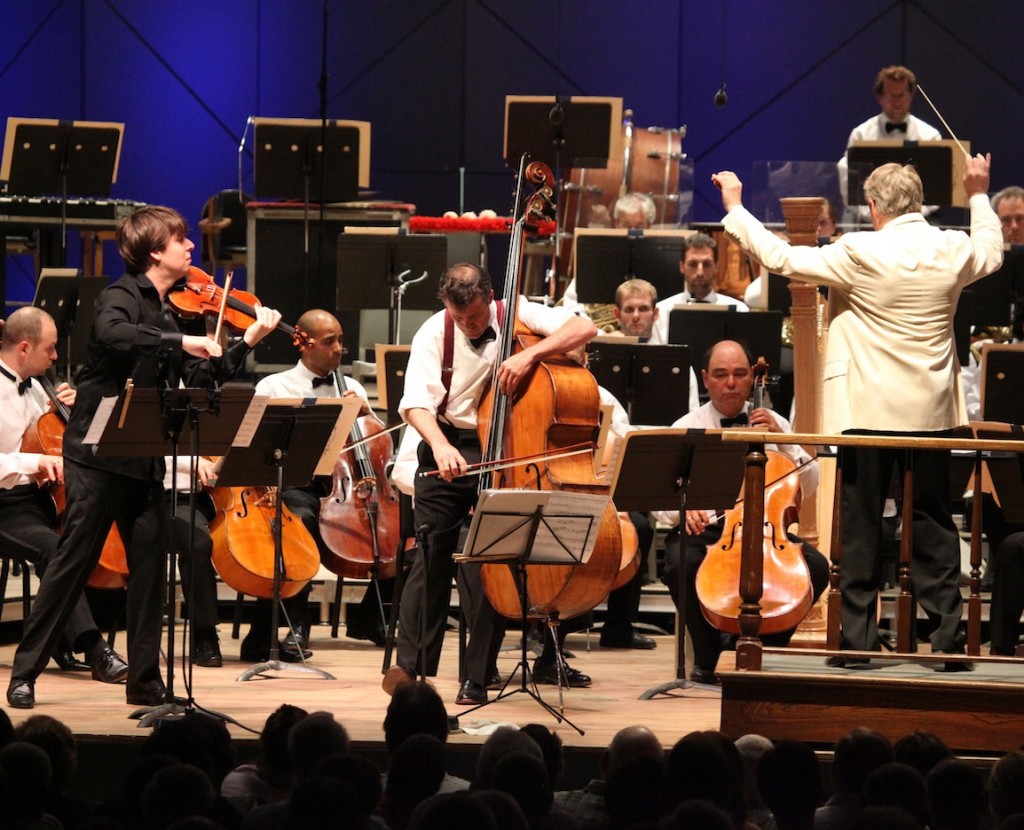With Joshua Bell, Meyer’s Double Concerto gets a lively premiere at Tanglewood

Joshua Bell and Edgar Meyer in the world premiere of Meyer's Double Concerto Friday night at Tanglewood with Michael Stern leading the BSO. Photo: Hilary Scott
Edgar Meyer’s Double Concerto for violin and double bass calls to mind the old saw about the dancing bear. The wonder isn’t that he does it clumsily, but that he does it at all.
Like the Terpsichorean bear, the 27-minute work — given its world premiere at Tanglewood Saturday night with Joshua Bell, conductor Michael Stern and the Boston Symphony Orchestra — virtually defies you not to like it. As is Meyer’s style, the concerto is cast in a lyrical, basically tonal style that seems a throwback to the neo-romantic modernism of Samuel Barber (whose School for Scandal Overture opened the program).
Meyer and Bell go back a long way. They met as fellow students at Indiana University and have kept up a collaboration that the Tanglewood program notes likened to “an extended, often interrupted jam session,” exploring repertoire inside and outside the classical tradition. The concerto was written for Bell, who teamed with the bassist-composer as duo-soloists.
Double concertos of this kind are rare, but other composers have tried their hand, if infrequently, at concertos for a single bassist. In earlier times, Bottesini, Vanhal and Dittersdorf gave it a shot. More recently, Serge Koussevitzky, himself a double bass virtuoso, composed one in his pre-BSO days, and Bostonian John Harbison wrote one for Edwin Barker, the BSO’s principal bassist.
Meyer’s three-movement work, in a traditional fast-slow-fast sequence, is essentially a showpiece for the violinist, with the bass subsidiary but never too far off. As performed at Tanglewood, the dialogue between soloists felt like conversations – friendly or otherwise – between a lively teenager and his sometimes gruff grandfather.
The first movement features a showy violin part over minimalist patterns in the orchestra, ending in a Bach-like chorale. The center movement is lyrical, with a rolling accompaniment, while the finale, full of fancy fiddling, is a hoedown, with call-and-response in the orchestra.
The attic-to-basement relationship between violin and bass as solo partners leaves an obvious gap that Meyer, who composes extensively for his instrument, has filled skillfully. The soloists meet and bounce off each other, and the orchestra cushions them. Both soloists performed with suave command, Bell dazzlingly so in his solos, and Stern and the BSO supplied attentive support.
To the delight of the audience, Bell warmed up for main event by whirling through the gypsy acrobatics of Ravel’s Tzigane with the orchestra.
The overstuffed program ended with Tchaikovsky’s Fourth Symphony in a performance with more bark than bite. Stern, making his Tanglewood debut, appeared to have been given inadequate preparation time for so much material on a tight summer rehearsal schedule.
Tanglewood’s opening BSO program Friday night featured Christoph von Dohnanyi leading the orchestra in a reprise of the all-Beethoven program – Leonore No. 3 and the Sixth and Fifth symphonies – with which Koussevitzky launched the festival 75 years ago. The performances were tightly focused and vividly played. Commemorative events, climaxing in a grand gala on July 14, are spread throughout the anniversary season.
Andrew L. Pincus is the classical music critic of The Berkshire Eagle and the author of two novels and three books on classical music.
Posted in Performances
